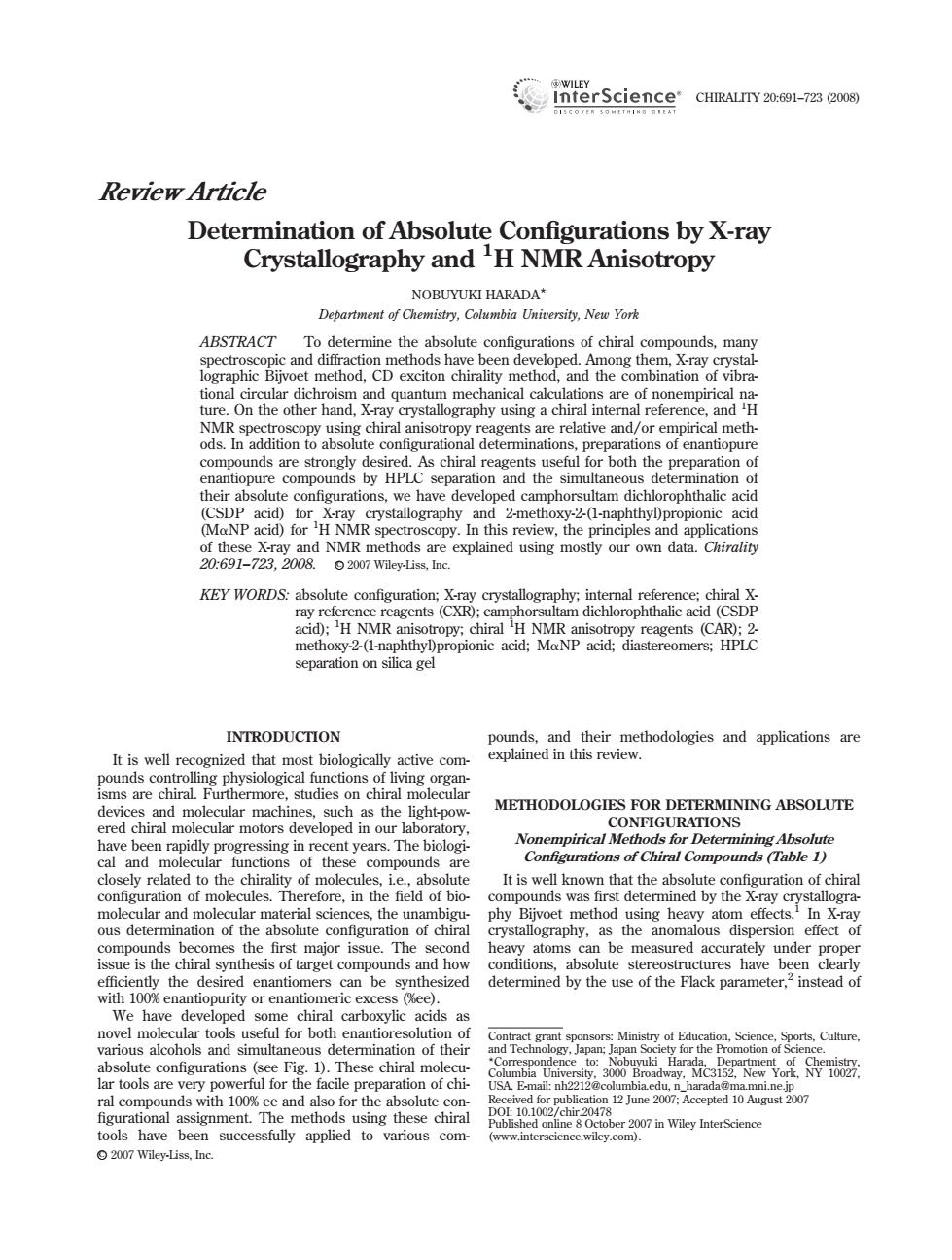正在加载图片...

interScience CHRAITY 0 Review Article Determination of Absolute Configurations by X-ray Crystallography and H NMR Anisotropy ABSTRACT Todetermine the absolute configurations of chiral comounds,many ing chiral anisotrop s are relative and/or empirical meth- ired.As chiral orboth the by HPLC separation and the simultaneou ermi and 2-mempho 2-(1-naph f the e and NMR methods are explained using stly our 20:691-723,2008. ©200 7 Wiley-liss.ne KEY WORDS:a acid): separation on silica gel INTRODUCTION pounds. and their methodologies and applications are It is well re nized that most biologically active com explained in this review s the light-po METHODOLOGIES FOR DETERMINING ABSOLUTE ng in n nt inine absolut o Chiral Com of t It is well known that the absolute ration of chira e,in the field unds was t det desired enantiomers can be synthesized determined by the use of the Flack parameter,instead of noemolecrtodsseitiorbothcnaniorEsoittionc Culture ion (1).These chiral also for the abs olute 12 June 2007;Accepted 10 August 007 2007 Wiley-Liss.IncReview Article Determination of Absolute Configurations by X-ray Crystallography and 1 H NMR Anisotropy NOBUYUKI HARADA* Department of Chemistry, Columbia University, New York ABSTRACT To determine the absolute configurations of chiral compounds, many spectroscopic and diffraction methods have been developed. Among them, X-ray crystallographic Bijvoet method, CD exciton chirality method, and the combination of vibrational circular dichroism and quantum mechanical calculations are of nonempirical nature. On the other hand, X-ray crystallography using a chiral internal reference, and 1 H NMR spectroscopy using chiral anisotropy reagents are relative and/or empirical methods. In addition to absolute configurational determinations, preparations of enantiopure compounds are strongly desired. As chiral reagents useful for both the preparation of enantiopure compounds by HPLC separation and the simultaneous determination of their absolute configurations, we have developed camphorsultam dichlorophthalic acid (CSDP acid) for X-ray crystallography and 2-methoxy-2-(1-naphthyl)propionic acid (MaNP acid) for 1 H NMR spectroscopy. In this review, the principles and applications of these X-ray and NMR methods are explained using mostly our own data. Chirality 20:691–723, 2008. VC 2007 Wiley-Liss, Inc. KEY WORDS: absolute configuration; X-ray crystallography; internal reference; chiral Xray reference reagents (CXR); camphorsultam dichlorophthalic acid (CSDP acid); 1 H NMR anisotropy; chiral 1 H NMR anisotropy reagents (CAR); 2- methoxy-2-(1-naphthyl)propionic acid; MaNP acid; diastereomers; HPLC separation on silica gel INTRODUCTION It is well recognized that most biologically active compounds controlling physiological functions of living organisms are chiral. Furthermore, studies on chiral molecular devices and molecular machines, such as the light-powered chiral molecular motors developed in our laboratory, have been rapidly progressing in recent years. The biological and molecular functions of these compounds are closely related to the chirality of molecules, i.e., absolute configuration of molecules. Therefore, in the field of biomolecular and molecular material sciences, the unambiguous determination of the absolute configuration of chiral compounds becomes the first major issue. The second issue is the chiral synthesis of target compounds and how efficiently the desired enantiomers can be synthesized with 100% enantiopurity or enantiomeric excess (%ee). We have developed some chiral carboxylic acids as novel molecular tools useful for both enantioresolution of various alcohols and simultaneous determination of their absolute configurations (see Fig. 1). These chiral molecular tools are very powerful for the facile preparation of chiral compounds with 100% ee and also for the absolute con- figurational assignment. The methods using these chiral tools have been successfully applied to various compounds, and their methodologies and applications are explained in this review. METHODOLOGIES FOR DETERMINING ABSOLUTE CONFIGURATIONS Nonempirical Methods for Determining Absolute Configurations of Chiral Compounds (Table 1) It is well known that the absolute configuration of chiral compounds was first determined by the X-ray crystallography Bijvoet method using heavy atom effects.1 In X-ray crystallography, as the anomalous dispersion effect of heavy atoms can be measured accurately under proper conditions, absolute stereostructures have been clearly determined by the use of the Flack parameter,2 instead of Contract grant sponsors: Ministry of Education, Science, Sports, Culture, and Technology, Japan; Japan Society for the Promotion of Science. *Correspondence to: Nobuyuki Harada, Department of Chemistry, Columbia University, 3000 Broadway, MC3152, New York, NY 10027, USA. E-mail: nh2212@columbia.edu, n_harada@ma.mni.ne.jp Received for publication 12 June 2007; Accepted 10 August 2007 DOI: 10.1002/chir.20478 Published online 8 October 2007 in Wiley InterScience (www.interscience.wiley.com). CHIRALITY 20:691–723 (2008) VC 2007 Wiley-Liss, Inc